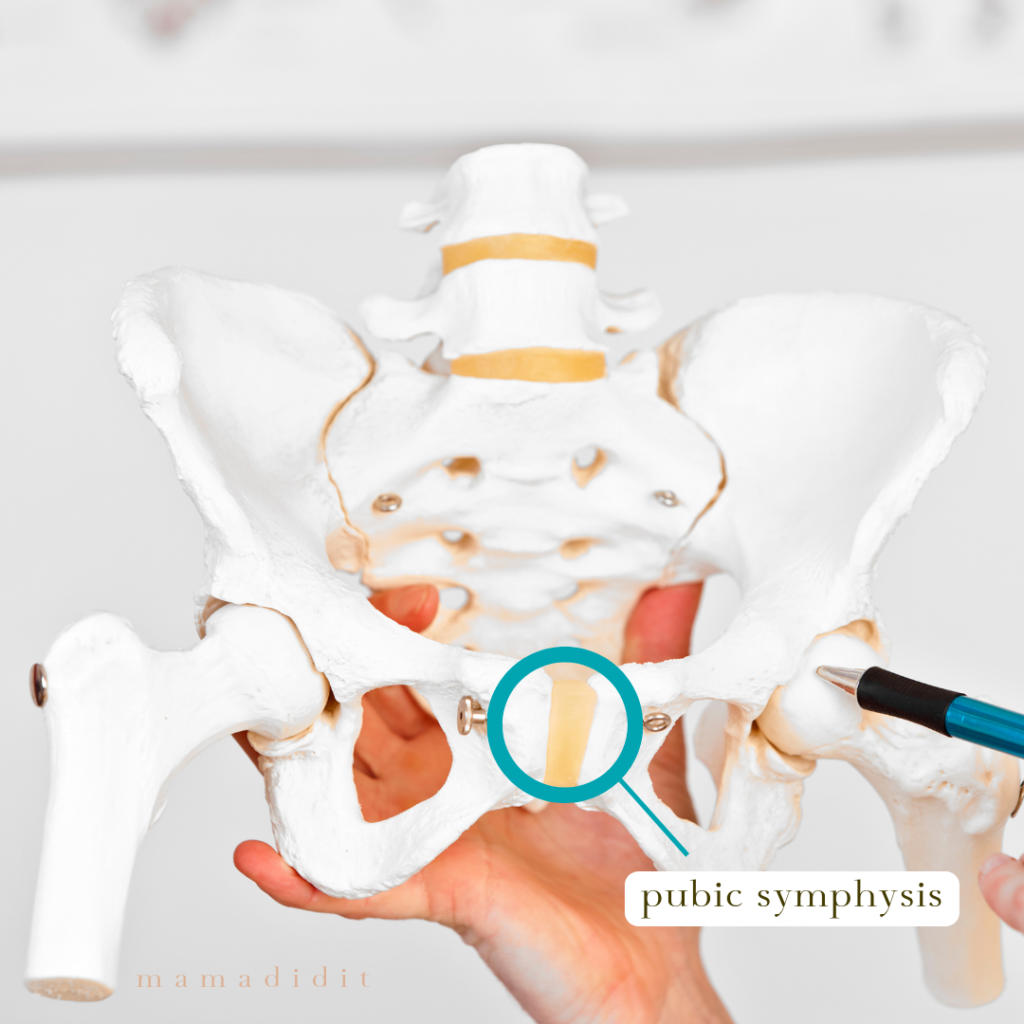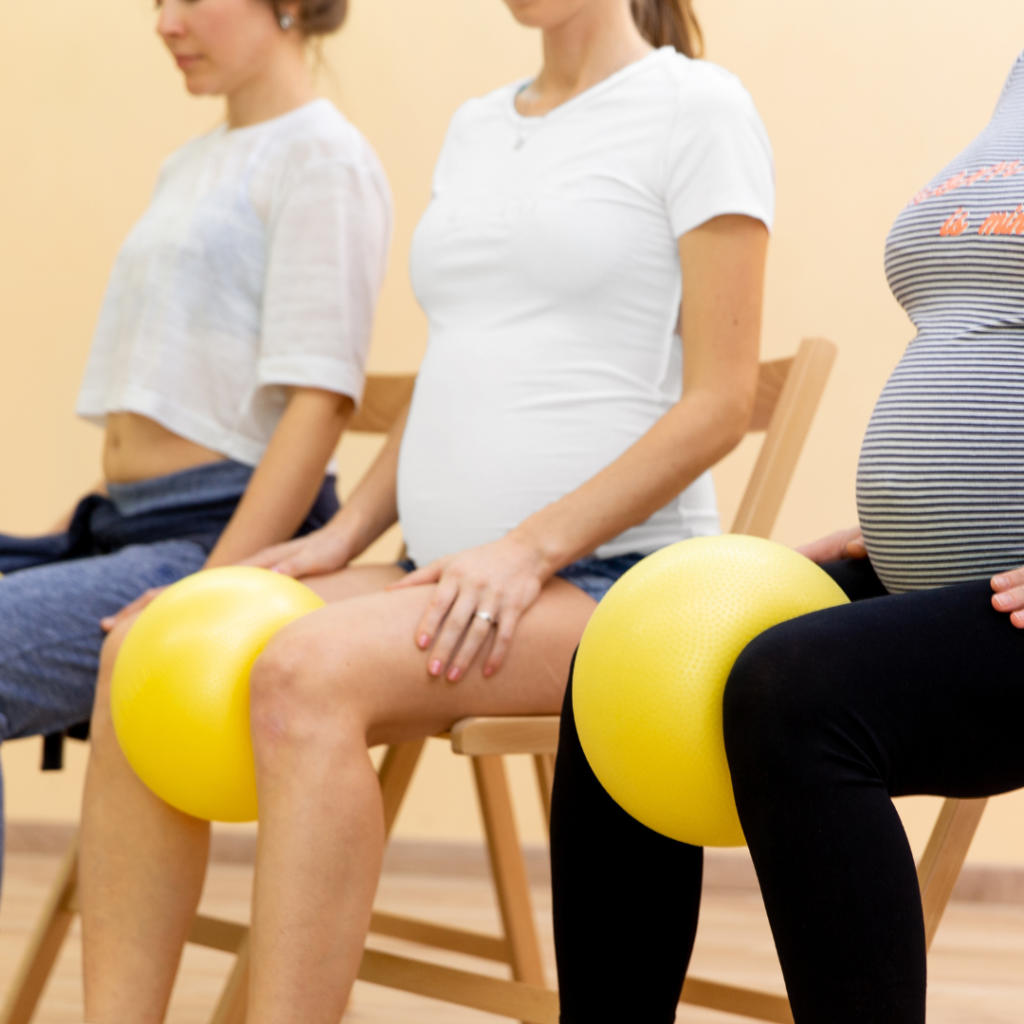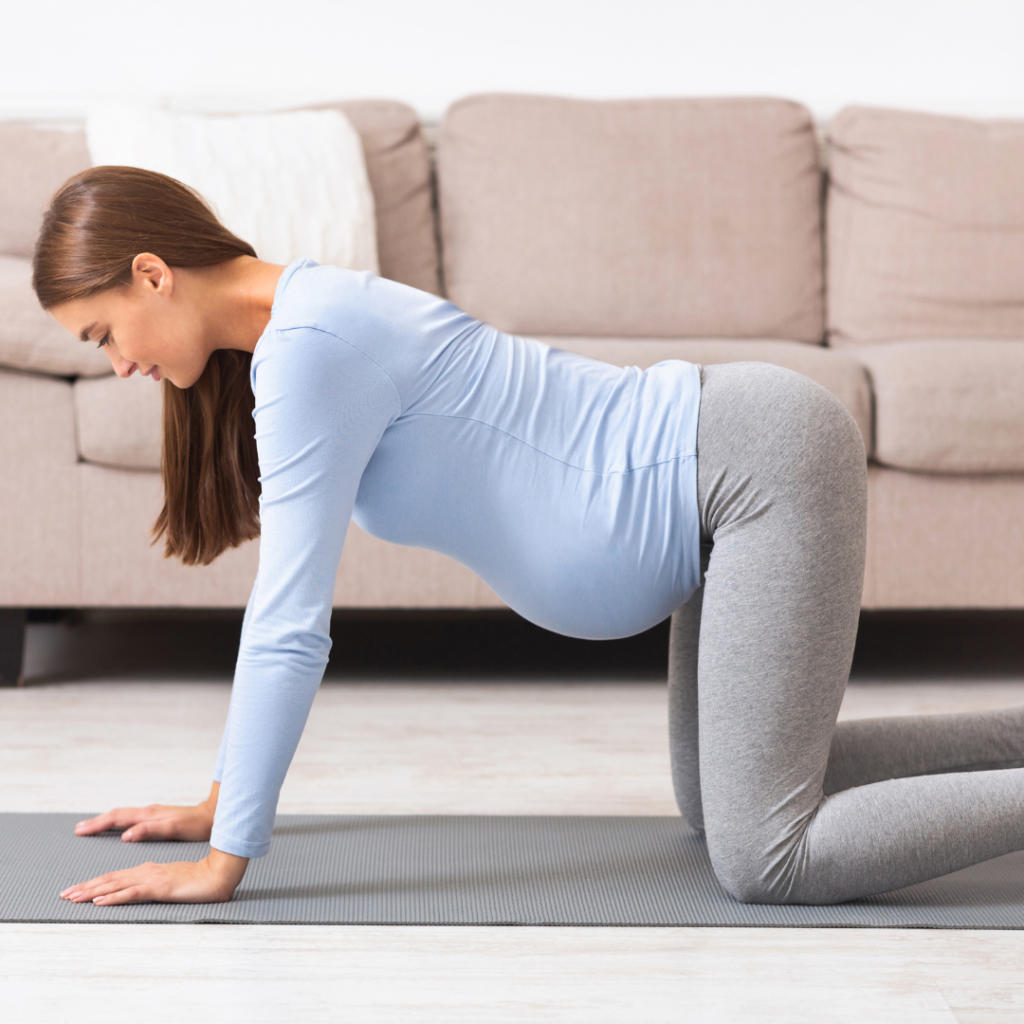Pelvic pain is one of the most common pregnancy complaints. Let’s look at how to relieve pelvic pain during pregnancy with things you can do right now.
When a person complains of “pelvic pain” they are usually referring to pain in the front of your pelvis. It is also described as pelvic pressure or pelvic discomfort. Let’s look at some different causes of pelvic pain and how to relieve pelvic pain during pregnancy. Plus, how to tell if it’s pelvic pain or lightning crotch.
Though the pelvic floor muscles could certainly be involved in pelvic pain, during pregnancy common symptoms of pelvic pain can come from symphysis pubis dysfunction. Symphysis pubis dysfunction occurs when the ligaments of the pelvic area get a little too loose and relaxed. This causes discomfort during walking or weight-bearing activities for pregnant women. Another reason you may experience pelvic pain is if the baby’s head is resting on the pelvic bone. Simply doing the activities below can bring relief.

Discomforts can occur when parts of our body become too tight or too loose. Balance is key because at times we need our pelvis stable and at times, we need it to relax for childbirth. Below we will discuss activities that can help achieve this.
Pain that occurs around your hips, your sacroiliac joints (SI joints), or the pubic symphysis (pelvic bone) could relate to the joints of your pelvis imbalance. This may feel like stiffness of your pelvic joints or tightness in your pelvic ligaments.
Other common pregnancy complaints are round ligament pain and or sciatic nerve discomfort. Round ligament pain is usually felt in the front of the belly. Sciatic nerve pain can usually be felt in the butt or running down the back of the leg.
Urinary tract infections aren’t usually felt in the bones of the pelvis. Common conditions of a UTI (urinary tract infection) are burning when urinating, not feeling like you can completely empty the bladder, and pain in the bladder (feel your right hip and go left by about three inches).
How to Relieve Pelvic Pain during Pregnancy
There are different ways to provide pelvic pain relief during pregnancy. Let’s start by looking at daily activities that can significantly improve the cause of pelvic pain. Daily activities can be started right away and don’t require extra expenses.
Positions to Relieve Pelvic Pain During Pregnancy
Daily Activities
Stretches to relieve pelvic pain during pregnancy can be done daily as long as exercise has been approved by your midwife or physician.
Ball Squeezes
Ball squeezes can provide pelvic stability as well as decrease incontinence or urinary urgency. These can also decrease pubic symphysis ache as well as promote pelvic floor health.
Sit in a chair on top of your sitz bones (your butt bones). Place a playground ball or pillow in between your knees. The goal is to engage your inner thighs, not squeeze hard. We aren’t trying to pop the ball. Inhale deeply. Slowly exhale and squeeze the ball as you exhale. Goal: do 5 repetitions of this exercise twice per day. Here’s a video tutorial.

Pelvic Tilts
Pelvic Tilts can increase pelvic stability which can strengthen the pelvic joints and relieve pelvic pain.
Start this exercise by getting on your hands and knees. Your back and neck should be flat. Relax your belly as you let it hang as you take a deep breath and inhale. Upon exhaling, make a “cat” position. raise your mid-back and tuck your chin as you wrap around your belly. Return to your start position as you inhale. Remember to breathe. Goal: 2-5 repetitions daily.

Pregnancy Pillow
To help maintain the work you have put in with daily activities, a pregnancy pillow can help you get in a comfortable position at night. Think about this: You can help facilitate posture and proper alignment through the night by sleeping well. This is perhaps eight-plus hours that your hips, your back, your knees, and shoulders can be in the ideal position. This pregnancy pillow is a great option.
When looking for a pregnancy pillow, choose one that goes not only in between your knees but your ankles as well. If the pillow doesn’t support your ankles, the bend of the ankle may pull the hip out of alignment. I know a lot of pillows, or a big pillow, can feel like too much in a bed space, but pillows are the best way to help your body into proper alignment for sleeping. Pregnancy pillows are a great way to help maintain the work you put in with stretching or exercise.
Pelvic Support Belt
A good pelvic support belt can lift the tummy and improve low back pain. It can also temporarily help your baby into a position where they aren’t resting on the pubic bone or pelvic region. Pelvic support belts are great to wear throughout the day to help decrease pelvic pain. Try this highly recommended one.
Warm Bath
There is nothing like a warm bath to help with pelvic discomfort. It also relieves tired muscles and low back pain as well as relaxes tension in the body. Adding a few drops of essential oils, like lavender and frankincense, can add even more relaxation as these oils promote a calming effect on the body and mood. These 2 oils are considered safe for pregnancy. Always check before using essential oils because some are not considered safe for pregnancy.
Supportive Shoes
If you stand or walk for long periods of time, it’s a good idea to invest in supportive shoes. Good shoes can help you maintain proper alignment and support for your legs. This may also reduce leg cramps that can be common in pregnancy. Wearing heels too often can shorten hamstrings, decrease hip flexibility, and cause an unaligned pelvis.
Physical Therapy
Seeing a prenatal physical therapist may be very helpful if you continue to experience discomfort and pain in pregnancy. A good physical therapist will assess your body, find where your muscles are over or under-compensating and teach you what to do about it. They can be a valuable part of your treatment plan.
Chiropractic Care
Seeking out a chiropractor, who specializes in pregnancy, can provide manual therapy to realign places in the body that may be out of alignment. A chiropractor can also teach you ways to maintain proper alignment from home. Manual manipulation in the right areas can help with pain management and be part of valuable treatment options.
Prenatal Yoga
I often recommend prenatal exercise classes to clients simply because there are very few times in your life you get to be a part of such a thing. To be in a community with other pregnant women can be such a gift. Prenatal yoga can improve sleep and mood. It also is specifically designed to strengthen and add flexibility to a pregnant woman’s body as well as address common symptoms she may be experiencing.
Prenatal Swim Class
Another wonderful option for relieving all kinds of pregnancy aches, discomfort, and tension is water aerobics. Water exercise prevents injuries, allows you to feel weightless, and relieves joint discomfort. It’s a great option for exercise during pregnancy.

Massage Therapy
A prenatal massage can work wonders for the body and mind. Make sure to visit a massage therapist that specializes in pregnancy. Massage therapy can relieve common pregnancy symptoms such as low back pain, leg cramps, and muscle tension. Massage shouldn’t be done if you are at risk for preterm labor.
Rest When You Can
Don’t ever push yourself through pain. Pain is our body’s way of letting us know that something needs attention. Discomfort and pain are indicators there need to be an adjustment. Rest when you can rest, and try one of the tips above to help your body.
Pelvic Pain or Lightning Crotch
Lightning crotch is different than pubic symphysis pain. Pubic symphysis pain usually occurs in the front of the pelvis right around the bone, whereas lightning crotch is deep within the pelvis. Pelvic pain usually occurs more long-term and can be felt throughout the day or night. It isn’t usually sudden and can be persistent. Pelvic pain can occur in the second trimester as well as the third trimester.
Lightning crotch usually is felt in the third trimester and comes from your growing baby putting pressure on your cervix and pelvis which can hit a nerve that sends a “lightning shock” into your groin area and possibly down your inner thigh. This is usually very quick-lived lasting less than one minute. Lightning crotch does not occur in the first trimester or early pregnancy, only in the late stage of pregnancy.
Don’t miss out on my top 10 tips for the last 10 weeks of pregnancy. Most don’t think of #4!
How to Relieve Pelvic Pain during Pregnancy
You should always speak with your healthcare provider before choosing which treatment option is right for you. They know your medical history and risk factors and can help you determine which may help you best. If you are ever experiencing sharp pain or severe pain during any of these activities, you should stop immediately.
Post may contain affiliate links
